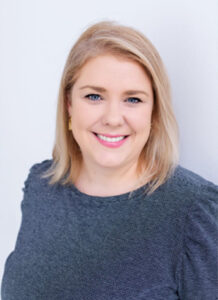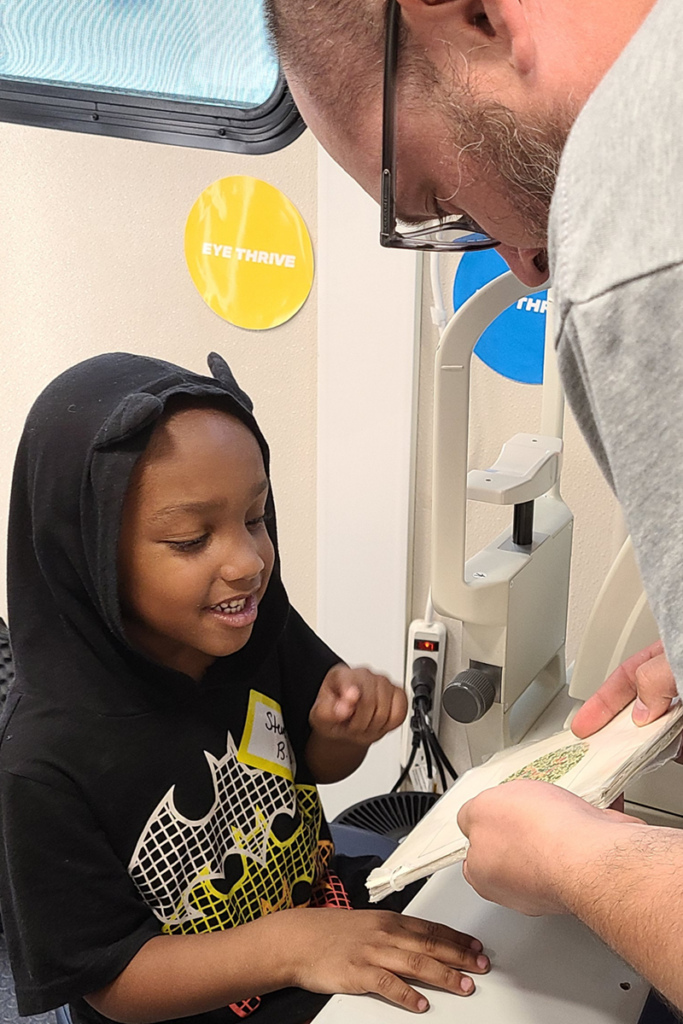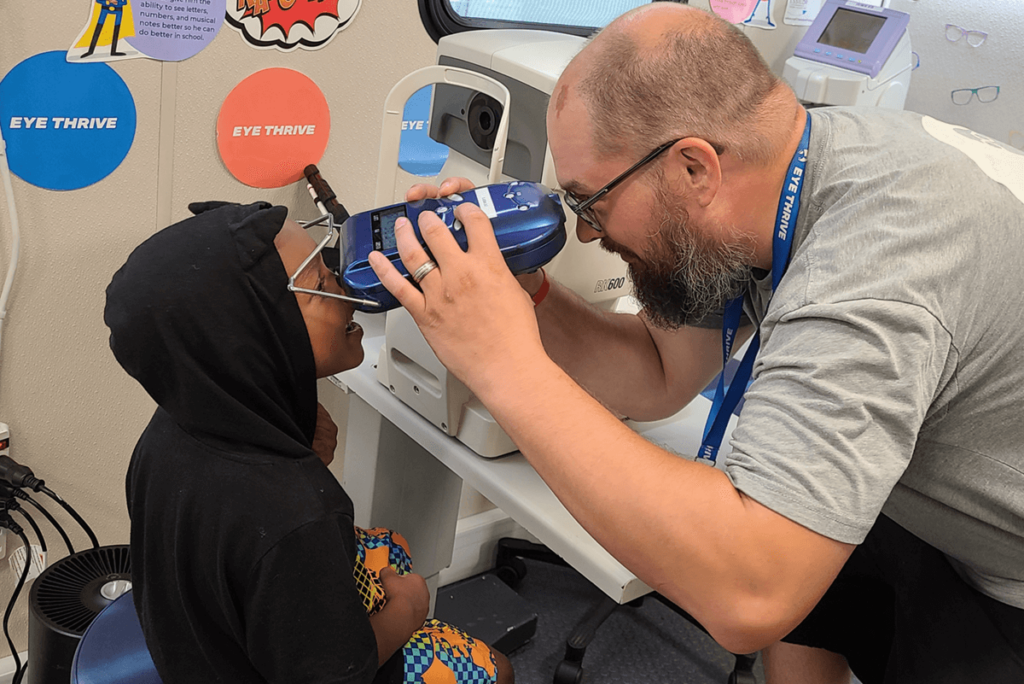
One out of every four children will have or need glasses by the time they enter kindergarten, according to a 2018 report by the American Optometric Association.
The non-profit Eye Thrive helps children in underserved areas who need glasses have them as early as possible through free vision services, including a mobile clinic where kids can get eye exams and prescription glasses on the spot.

Executive Director Kate McKearn joined Eye Thrive in 2016, after spending over a decade teaching in public schools in Chicago and St. Louis. She says, “I realized the inequities in our educational system firsthand and just immersed myself into finding a way to lessen that gap.”
Kate remembers a fifth grader in the St. Louis Public Schools who was reading at a third grade level. He had a stack of behavioral referrals, was on ADHD medication, and was being fast-tracked for an individualized educational plan (IEP). “I noticed he kept squinting,” she says. “It didn’t matter how close I put him.”
Kate worked with the boy’s mother to get an eye exam and glasses and discovered he had a very significant prescription. Soon, he was reading at a sixth grade level, no longer took medications, and was not eligible for an IEP. “He was the best behaved kiddo in my class. All of those labels, they weren’t even valid.”
A trusted partner
Missouri stopped requiring school vision screenings, in which a school nurse or employee has the child read an eye chart—for first and third graders in 2015, though some schools elect to continue screening. In 2018, the state stopped requiring comprehensive vision exams, performed by a state licensed optometrist or physician, for children enrolling in kindergarten or first grade
In 2016, Eye Thrive saw about 1,800 kids in over 60 schools in St. Louis City and County. This year, they expect to provide vision screenings to more than 13,000 kids, over 4,500 eye exams, and about 7,000 pairs of glasses.

Eye Thrive provides vision screenings within schools to kids in Pre-K through eighth grade, with the hope that they’ve caught everyone before high school. Program specialists Mary McKeehan and Dawnita Reathaford meet with the school nurse to discuss schedule and needs, and then spend a few minutes in each classroom introducing themselves.
At screening time, Dawnita and Mary revisit each class and screen each child in the hallway just outside the classroom for about 3 to 4 minutes each. If the child fails the vision screening, the parents will receive a letter explaining the potential vision impairment and when the Mobile Vision Clinic will visit the school for a vision exam. The parents also receive a consent form. Kate says one of the biggest barriers is getting consent forms back. She says the Hazelwood School District sends consents to families electronically at the beginning of the year, resulting in a nearly 90 percent response.
During the summer break, Eye Thrive takes its mobile clinic to area libraries. Registration opens at 9 a.m., though families start lining up at 7 a.m., and are given a time slot between 9 a.m. and 2 p.m. Eye Thrive often tries to schedule a second visit the following day in areas of greatest need.
The Mobile Vision Clinic serves children from Pre-K through 12th grade. Kate says, “We’re getting kids ready for school, so they can start with everything they need.” She enjoys the interactions with families. “Most of the time, during the school year, we’re interacting with teachers and nurses and school personnel, but not so much their parents.”
Eye Thrive has a “no questions asked” replacement program. Kate remembers as a teacher how kids could lose or break their glasses. She says some kids are living transitional lives where they must pack up and leave within minutes in the middle of the night and may forget them.
“Just tell us you need a new pair. We don’t need to know the reason.”
Kate McKearn
The whole idea of providing wraparound services – from pre-visit to replacement glasses – came from a parent survey response. “We originally piloted our screening program right before COVID, in fall 2019, with the Hazelwood School District,” Kate says. “It was just screenings and clinic; there was no pre-visit, no post-visit. We still had referrals and replacements, but each step was a different person.”
Dawnita and Mary go over the results with the nurses, find out if a child has replacement needs, and follow up on referrals.
Aboard the vision clinic
The blue, white, and gold Mobile Vision Clinic makes good use of the space inside, peppered with colorful cartoon images, displays and books to read, and photos of satisfied clients. Kate says it’s important to have a clean, bright, welcoming space. “We are the trusted provider,” she says. “Some of our kids and families—we’re the first provider they’ve seen outside of an urgent care or an ER room.”
Kate says, “If a kiddo’s not comfortable at first, we’ll let them sit back and watch and ask questions. It’s about that empowering experience. ‘Let me explain everything that’s going to happen before it’s going to happen.’ All of that prep work that goes into building that relationship of trust.” Staff are trained as trauma-informed caregivers to identify potentially abused or neglected kids.
The comprehensive exam takes about 20 to 40 minutes, depending on the age of the child.
The child will first meet Internal Optical Coordinator Bill George, who will provide an auto-refractor test to measure the shape and size of the cornea and get a base prescription. He will also test for color blindness and depth perception.
Eye Thrive will have the child see one of the two onboard optometrists to refine prescription strength and look at the health of the eye. The exam may include retinal imaging and measuring eye pressure. If the lens strength is between -5.00 (nearsightedness) to +5.00 (farsightedness) diopters, the child can have the glasses made onsite. Stronger prescriptions are sent to Midland Optical.
If an optometrist finds anything unusual or thinks a second look is needed, Eye Thrive provides a referral for follow-up care at Washington University in St. Louis or University of Missouri-St. Louis. Staff work with families to get them into the appointment. Kate says nearly all their families are enrolled or are eligible for Medicaid, for which providers may only maintain a certain number of slots. Eye Thrive staff will fax a copy of the referral to the provider. “If it is something urgent,” Kate explains, “we can say, ‘We need to get them in there now!’ Let’s work this out.”
Eye Thrive can help with transportation if needed, and any child who has a high prescription or has needs based on a disability will get two pairs of glasses.
When a child needs glasses, External Optical Coordinator Brandon Hinkle creates the prescription lenses. He starts by assisting them in selecting the donated frames, including designer brands. Choosing the frames is one of Kate’s favorite parts of the process.
“There’s no one telling them what they need to pick. If they say they want a red pair of glasses, we’re going to find them a red pair of glasses”
Kate McKearn
Brandon then invites them to watch how the lenses are made. Kate says it’s powerful for the children to see a successful African American male making their glasses and talking about his experiences. She says Brandon’s extensive optical experience and skills in the onboard lab is something she will never be able to do. She is also aware the children could be forming ideas of what optical careers may be available.
Upon exiting the clinic, the child is given a Thrive kit: a small bag containing their prescription, glasses case, a cleaning kit, and information about Eye Thrive or one of its sponsors. All the frames, lenses, cases, and cleaning kits are 100 percent donated. Any child who has glasses will be seen annually due to vision changes that can occur over time.
A vision for the future








Eye Thrive has a staff of 11 full-time and four part-time positions. This fall, Kate is hoping to hire a third program specialist. Each program specialist screens between 6,000 and 7,000 kids.
Kate says the move to mobile health has exploded in the past few years and is improving access to care. Eye Thrive is working to add a second Mobile Vision Clinic in the next two years. She says it would take four vehicles with staffing to get to all St. Louis Public Schools.
As a nonprofit, Eye Thrive relies heavily on volunteers to assist with creating Thrive kits, entering data, and inventory. Recently, staff worked with a software developer to create an electronic medical record (EMR) system. Kate says the only EMR system that had existed for the vision world catered to for-profit organizations, tracking frames, cost, and billing. “They don’t have anything for parent contacts, screening results, referrals, or replacements,” she says. Prior to the new EMR system, Eye Thrive used 12 different platforms.
Kate would love to have more quantitative data to assess impact, such as the reading level of a child before and after. She would love to see a study similar to the study by Johns Hopkins University School of Medicine in Baltimore City Public Schools which found glasses were the equivalent of two to four months of additional education. For students performing in the lowest quartile and those in special education, glasses equated to four to six months of additional learning. The study did not provide comprehensive exams, only refraction testing.
Eye Thrive moved to the collaborative space Delmar DivINe last year. One of the reasons for the move was to increase diversity within the organization. In hiring, Kate says she’s been looking more at experiences that may compensate for formal education and is working to add more diversity to the board, including a community member and a school nurse.
Kate says the biggest impact she’s ever seen in her six years with Eye Thrive was when a despondent and quiet four-year-old girl came onto the clinic. Kate tried reading with her, but she wasn’t interested. The girl ended up having a high prescription and was both far-sighted and had a severe astigmatism. After picking out her purple pair of glasses, the girl looked around—with glasses on and off—and began happily running and jumping. Kate still has the video of the girl pointing to a dandelion and asking, “What is that?” Kate still gets goosebumps thinking about it and says, “Her whole demeanor changed, and it’s just a pair of glasses, that’s it! Her life has literally changed right in front of my eyes.” Kate also points out these are the people who are going to be taking care of us one day. “If all they need is a pair of glasses, that’s such an easy fix.”